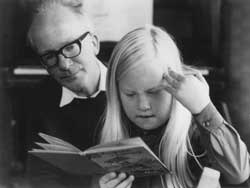The significance of early reading for children with Down syndrome
Reading is one of the most powerful ways of helping children with Down syndrome to overcome their speech, language and cognitive delays.
Buckley, S. (2002) The significance of early reading for children with Down syndrome. Down Syndrome News and Update, 2(1), 1-1. doi:10.3104/practice.152
Some readers will know that the work of Down Syndrome Education International began in 1980 as a result of the observations of a parent. In 1979 Leslie Duffen wrote to Sue Buckley about the progress of his daughter Sarah, then 11 years of age and attending a mainstream school. Sarah was making exceptional progress for a child with Down syndrome and Leslie felt that a major reason for this was her early reading experience. He had introduced her to reading from the age of 3 years and he felt that she had learned to talk from seeing rather than hearing the language. Sue and her colleagues began to research Leslie's suggestions and found that they were able to teach a sight vocabulary to preschoolers with Down syndrome and that it did help their language and cognitive development in the way Leslie predicted.

Leslie and Sarah Duffen
Twenty years on, research from around the world has demonstrated that children with Down syndrome do indeed have specific difficulties in learning from listening due mainly to hearing, auditory processing and verbal short-term memory difficulties. These difficulties will significantly impair their ability to learn their first language from listening and, in turn, language delay leads to increasing cognitive delay. Our experience leads us to believe that reading is one of the most powerful ways of helping children with Down syndrome to overcome their speech, language and cognitive difficulties. In particular it develops their grammar and speech production abilities at the optimal time in brain development. However, many professionals working in early intervention services are still not aware of the importance of early reading activities, so many parents and children do not receive the help and advice that they need at the preschool stage.
Common points from these examples
These descriptions of children's progress around the world all highlight that:
- words children read transfer rapidly to speech
- reading 2 then 3 word 'phrases' transfers their use to speech
- reading sentences teaches grammar
- reading words and sentences develops clearer speech production (articulation and phonology)
Parents and teachers in other countries have also been discovering the power of print for children with Down syndrome and we include here some examples of the progress of children in the USA (example 1 and example 2), New Zealand and Turkey described by their parents. We hope that these examples will encourage parents, speech and language therapists, early intervention and preschool staff to realise the benefits and importance of early reading activities. These children were all taught by their parents and we hope that everyone will see that no special knowledge is required. We have recently published a guide to teaching reading to preschoolers [1] and we have made several videos in recent years which show children with Down syndrome engaged in reading activities to encourage everyone. [2] No special knowledge is required - every parent teaches their child to talk, and using reading to teach talking just follows the same principles, with the use of print.
At the end of these features on early reading we include a summary of a recent research study which compared the reading skills of preschool children with Down syndrome and preschool typically developing children of the same chronological age over a three year period. Both groups learned initial sight words at the same rate, and progress after 3 years clearly demonstrated that reading ability is a strength for many children with Down syndrome.
References
- Reading and writing development for infants with Down syndrome [DSii-07-02] by Gillian Bird and Sue Buckley, published by Down Syndrome Education International, see Reading resource list below.
- Reading videos, see Reading resource list below.
Reading resource list
Online:
- Love and Learning https://www.loveandlearning.com
- Reading before talking: Learning about mental abilities from children with Down syndrome. Inaugural lecture by Sue Buckley at the University of Portsmouth, 9th May 1996. https://www.down-syndrome.info/library/papers/1996/05/reading/
- Hooked on Phonics https://www.hookedonphonics.com
The following items are available from Down Syndrome Education International's online shop:
- Reading and writing for individuals with Down syndrome - An overview. By Sue Buckley (2001). Portsmouth, UK: The Down Syndrome Educational Trust. ISBN: 1-903806-09-7. ]
- Reading and writing for infants with Down syndrome (0-5 years). By Gillian Bird and Sue Buckley (2001). Portsmouth, UK: The Down Syndrome Educational Trust. ISBN: 1-903806-10-0. ]
- Reading and writing for children with Down syndrome (5-11 years). By Gillian Bird, Jane Beadman and Sue Buckley (2002). Portsmouth, UK: The Down Syndrome Educational Trust. ISBN: 1-903806-11-9. ]
- Reading and writing development for teenagers with Down syndrome (11-16 years). By Gillian Bird and Sue Buckley (2002). Portsmouth, UK: The Down Syndrome Educational Trust. ISBN: 1-903806-12-7. ]
- Teaching reading to children with Down syndrome - a guide for parents and teachers. By Patricia Oelwein. ISBN: 0-933149-55-7.
Videos/DVDs available from the DSE online store:
- Reading Skills in Pre-school Children with Down Syndrome. By Elizabeth Wood and Sue Buckley. (1983). Portsmouth, UK: Portsmouth Polytechnic.
- Understanding Down syndrome (2) - learning to read. By Sue Buckley and Gillian Bird (1995). Portsmouth, UK: The University of Portsmouth
- The Development of Language and Reading Skills in Children with Down Syndrome. By Sue Buckley, Maggie Emslie, Gillian Haslegrave, and Pat Le Prevost (1986). Portsmouth, UK: Portsmouth Polytechnic.

